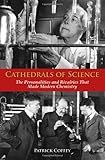|
Editorial Review Product Description
In Cathedrals of Science, Patrick Coffey describes how chemistry got its modern footing-how thirteen brilliant men and one woman struggled with the laws of the universe and with each other.They wanted to discover how the world worked, but they also wanted credit for making those discoveries, and their personalities often affected how that credit was assigned. Gilbert Lewis, for example, could be reclusive and resentful, and his enmity with Walther Nernst may have cost him the Nobel Prize; Irving Langmuir, gregarious and charming, "rediscovered" Lewis's theory of the chemical bond and received much of the credit for it. Langmuir's personality smoothed his path to the Nobel Prize over Lewis.
Coffey deals with moral and societal issues as well.These same scientists were the first to be seen by their countries as military assets.Fritz Haber, dubbed the "father of chemical warfare," pioneered the use of poison gas in World War I-vividly described-and Glenn Seaborg and Harold Urey were leaders in World War II's Manhattan Project; Urey and Linus Pauling worked for nuclear disarmament after the war. Science was not always fair, and many were excluded.The Nazis pushed Jewish scientists like Haber from their posts in the 1930s.Anti-Semitism was also a force in American chemistry, and few women were allowed in; Pauling, for example, used his influence to cut off the funding and block the publications of his rival, Dorothy Wrinch.
Cathedrals of Science paints a colorful portrait of the building of modern chemistry from the late 19th to the mid-20th century. ... Read more Customer Reviews (6)  Persosnalities in Science
Persosnalities in Science
I enjoyed the book, and relished the little nuggets of knowledge such as :
G.N. Lewis invented "activity","fugacity", "ionic strength" and "photon" as terminology. "Lewisite" was named for a different Lewis.
I had not realized how involved he was in heavy water and isotopic labeling.
The material on Haber was interesting, but much of it was available elsewhere.
I had never read much about Langmuir before- his life was fascinating:
the mountain climbing, the connection with Kurt Vonnegut etc., and of course his work on chemical bonding and surface chemistry. I was impressed that he spoke fluent French and German.
Nernst I want to read more about, and Ostwald.
A theme throughout the book was the extreme sensitivity of many of these scientists to personal slights, quarrels over priority and the like.
Academic advancement depends on reputation-makes people crazy over things
many of the rest of us would let pass.
Dorothy Wrinch was new to me. Feminists may find her story pathetic, but possibly less so than that of Rosalind Franklin.
The assertion (p.209) that the first transmutation of an isotope of one element into that of another was done at Berkeley is most likely incorrect. I also found confusing the statement that an isotope had been
formed by bombarding something with neutrons in a cyclotron. I suspect some technicalities were left out in respect of general readers.
 The story of Lewis and Langmuir
The story of Lewis and Langmuir
I am a physical chemistry faculty member at Berkeley, in the chemistry department that G. N. Lewis built, and I am also the recipient of the 2005 Irving Langmuir Prize in Chemical Physics.So understandably, I am interested in learning about these two towering and competing figures.Coffey's book is about these two men and a few others who contributed to creating the field of physical chemistry during the first half of the 20th century. His descriptions of scientific principles are vivid and accurate, and his stories about Lewis and Langmuir are fascinating.In view of the former, I trust the accuracy of the latter.I recommend this book to anyone interested in the history of science in general, and the history of physical chemistry in particular.
 Captivating Narative / Detailed Research
Captivating Narative / Detailed Research
I really enjoyed Cathedrals of Science.The narrative was every bit as captivating as a historical fiction, yet the detailed research gives one a rewarding insight into an extremely interesting subject and historical time period. As with many, I have read extensively on the popularly know quantum physics pioneers. Coffey's work more broadly illuminates the "age defining" discoveries and key personalities of the period.I found the author's discussions of the Pathological Science of Langmuir especially relevant to today's political - scientific discourse.
 great book for any engineer
great book for any engineer
A great read! I liked the way the author describes the different work cultures and habits of both Lewis and Langmuir...academia vs. industry.
The author's plain talk about "the battles over priority of invention" and the scientific discovery methods gave me much insight into my own career in software engineering.
One other thing that I _really_ liked was the feeling that I had just taken a refresher chemistry class (except this was way more fun :-)
 Food for thought
Food for thought
When I finished reading this fascinating book, I found myself wondering: why have physics and physicists been the subjects of so many biographies, other nonfiction, novels, plays, and even opera - and chemistry and chemists so few? Not for lack of significance: Chemistry is Us. And not for lack of dramatic potential: as Patrick Coffey shows very skillfully, the history of modern chemistry is replete with profound moral quandaries, contentious outsize personalities, and epic quarrels. I recommend Cathedrals of Science to everyone, even if you've forgotten your chemistry (the author stirs it in gently). This is a compelling story, with much food for thought.
... Read more
|
